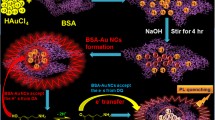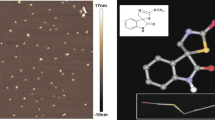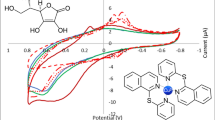Abstract
Gold nanoclusters (AuNCs) stabilized with bovine serum albumin were utilized as a fluorescent probe for ferrous ion. The detection scheme is based on the quenching of the fluorescence of the modified AuNCs by hydroxyl radical (•OH) that is generated in the Fenton reaction between Fe(II) and H2O2. Fe(II) can be quantified in the 0.08 to 100 μM concentration range, and the limit of detection is as low as 24 nM. The method also displays good accuracy and high sensitivity when employed to the determination of Fe(II) in rat cerebrospinal fluids (CSFs). When applied to CSFs of a rat model of Alzheimer’s disease, it revealed enhanced levels of Fe(II) compared to a control, thereby showing the important physiological role of iron(II) in this disease.

BSA-stabilized gold nanoclusters (BSA-AuNCs) were utilized for the determination of ferrous ion in rat cerebrospinal fluids. The method is based on the quenching of the fluorescence by hydroxyl radical (•OH) which is generated in the Fenton reaction between Fe(II) and H2O2.





Similar content being viewed by others
References
Hentze MW, Muckenthaler MU, Galy B, Camaschella C (2010) Two to tango: regulation of mammalian iron metabolism. Cell 142:24
Brissot P, Ropert M, Lan CL, Loréal O (2012) Non-transferrin bound iron: a key role in iron overload and iron toxicity. Biochim Biophys Acta 1820:403
Vecchi C, Montosi G, Zhang KZ, Lamberti I, Duncan SA, Kaufman RJ, Pietrangelo A (2009) ER stress controls iron metabolism through induction of hepcidin. Science 325:877
Cao HY, Chen ZH, Zheng HZ, Huang YM (2014) Copper nanoclusters as a highly sensitive and selective fluorescence sensor for ferric ions in serum and living cells by imaging. Biosens Bioelectron 62:189
Chen YT, Jiang JZ (2013) N,N-di(2-pyridylmethyl)amino-modified porphyrinato zinc complexes. The “ON–OFF” fluorescence sensor for Fe3+. Spectrochim Acta A Mol Biomol Spectrosc 116:418
Feldheim D (2000) Nanotechnology: flipping a molecular switch. Nature 408:45
Li G, Jin RC (2014) Gold nanocluster-catalyzed semihydrogenation: a unique activation pathway for terminal alkynes. J Am Chem Soc 136:11347
Lin CA, Yang TY, Lee CH, Huang SH, Sperling RA, Zanella M, Li JK, Shen JL, Wang HH, Yeh HI, Parak W, Chang WH (2009) Synthesis, characterization, and bioconjugation of fluorescent gold nanoclusters toward biological labeling applications. ACS Nano 3:395
Hofmann CM, Essner JB, Baker GA, Baker SN (2014) Protein-templated gold nanoclusters sequestered within sol–gel thin films for the selective and ratiometric luminescence recognition of Hg2+. Nanoscale 6:5425
Santhosh M, Chinnadayyala SR, Kakoti A, Goswami P (2014) Selective and sensitive detection of free bilirubin in blood serum using human serum albumin stabilized gold nanoclusters as fluorometric and colorimetric probe. Biosens Bioelectron 59:370
Chan PH, Chen YC (2012) Human serum albumin stabilized gold nanoclusters as selective luminescent probes for staphylococcus aureus and methicillin-resistant staphylococcus aureus. Anal Chem 84:8952
Lin H, Li LJ, Lei CY, Xu XH, Nie Z, Guo ML, Huang Y, Yao SZ (2013) Immune-independent and label-free fluorescent assay for Cystatin C detection based on protein-stabilized Au nanoclusters. Biosens Bioelectron 41:256
Park KS, Kim MI, Woo MA, Park HG (2013) A label-free method for detecting biological thiols based on blocking of Hg2+-quenching of fluorescent gold nanoclusters. Biosens Bioelectron 45:65
Jin LH, Shang L, Guo SJ, Fang YX, Wen D, Wang L, Yin JY, Dong SJ (2011) Biomolecule-stabilized Au nanoclusters as a fluorescence probe for sensitive detection of glucose. Biosens Bioelectron 26:1965
Cui ML, Liu JM, Wang XX, Lin LP, Jiao L, Zhang LH, Zheng ZY, Lin SQ (2012) Selective determination of cysteine using BSA-stabilized gold nanoclusters with red emission. Analyst 137:5346
Wang XX, Wu Q, Shan Z, Huang QM (2011) BSA-stabilized Au clusters as peroxidase mimetics for use in xanthine detection. Biosens Bioelectron 26:3614
Zhang N, Si YM, Sun ZZ, Li S, Li SY, Lin YH, Wang H (2014) Lab-on-a-drop: biocompatible fluorescent nanoprobes of gold nanoclusters for label-free evaluation of phosphorylation-induced inhibition of acetylcholinesterase activity towards the ultrasensitive detection of pesticide residues. Analyst 139:4620
Liu YL, Ai KL, Cheng XL, Huo LH, Lu LH (2010) Gold-nanocluster-based fluorescent sensors for highly sensitive and selective detection of cyanide in water. Adv Funct Mater 20:951
Xie JP, Zheng YG, Ying JY (2010) Highly selective and ultrasensitive detection of Hg2+ based on fluorescence quenching of Au nanoclusters by Hg2+–Au+ interactions. Chem Commun 46:961
Chen TT, Hu YH, Cen Y, Chu X, Lu Y (2013) A dual-emission fluorescent nanocomplex of gold-cluster-decorated silica particles for live cell imaging of highly reactive oxygen species. J Am Chem Soc 135:11595
Tao Y, Wang Y, Rogers JT, Wang F (2014) Perturbed iron distribution in Alzheimer’s disease serum, cerebrospinal fluid, and selected brain regions: a systematic review and meta-analysis. J Alzheimers Dis 42:679
Xie JP, Zheng YG, Ying JY (2009) Protein-directed synthesis of highly fluorescent gold nanoclusters. J Am Chem Soc 131:888
Liu DB, Chen WW, Tian Y, He S, Zheng WF, Sun JH, Wang Z, Jiang XY (2012) A highly sensitive gold-nanoparticle-based assay for acetylcholinesterase in cerebrospinal fluid of transgenic mice with Alzheimer’s disease. Adv Healthcare Mater 1:90
Zheng J, Nicovich PR, Dickson RM (2007) Highly fluorescent noble metal quantum dots. Annu Rev Phys Chem 58:409
Melo TM, Larsen C, White LR, Aasly J, Sjobakk TE, Flaten TP, Sonnewald U, Syversen T (2003) Manganese, copper, and zinc in cerebrospinal fluid from patients with multiple sclerosis. Biol Trace Elem Res 93:1
Hu LZ, Deng L, Alsaiari S, Zhang DY, Khashab NM (2014) “Light-on” sensing of antioxidants using gold nanoclusters. Anal Chem 86:4989
Kim WS, Ye X, Rubakhin SS, Sweedler JV (2006) Measuring nitric oxide in single neurons by capillary electrophoresis with laser-induced fluorescence: use of ascorbate oxidase in diaminofluorescein measurements. Anal Chem 78:1859
Mesquita SD, Ferreira AC, Sousa JC, Santos NC, Correia-Neves M, Sousa N, Palha JA, Marques F (2012) Modulation of iron metabolism in aging and in Alzheimer’s disease: relevance of the choroid plexus. Front Cell Neurosci 6:1
Li P, Fang LB, Zhou H, Zhang W, Wang X, Li N, Zhong HB, Tang B (2011) A New ratiometric fluorescent probe for detection of Fe2+ with high sensitivity and its intracellular imaging applications. Chem Eur J 17:10520
Hirayama T, Okuda K, Nagasawa H (2013) A highly selective turn-on fluorescent probe for iron(II) to visualize labile iron in living cells. Chem Sci 4:1250
Kim H, Na YJ, Song EJ, Kyung KKB, Bae JM, Kim C (2014) A single colorimetric sensor for multiple target ions: the simultaneous detection of Fe2+ and Cu2+ in aqueous media. RSC Adv 4:22463
Praveen L, Reddy MLP, Varma RL (2010) Dans SQ can be used as turn-on fluorescent sensor for Fe2+. Tetrahedron Lett 51:6626
Acknowledgments
This work was supported by National Natural Science Foundation of China (21105057), Promotive Research Fund for Excellent Young and Middle-aged Scientist of Shandong Province (BS2013SW002) and Innovative Training Project for Undergraduate Students of Shandong Normal University.
Author information
Authors and Affiliations
Corresponding authors
Electronic supplementary material
Below is the link to the electronic supplementary material.
ESM 1
(DOC 11625 kb)
Rights and permissions
About this article
Cite this article
Yang, S., Jiang, Z., Chen, Z. et al. Bovine serum albumin-stabilized gold nanoclusters as a fluorescent probe for determination of ferrous ion in cerebrospinal fluids via the Fenton reaction. Microchim Acta 182, 1911–1916 (2015). https://doi.org/10.1007/s00604-015-1525-5
Received:
Accepted:
Published:
Issue Date:
DOI: https://doi.org/10.1007/s00604-015-1525-5




